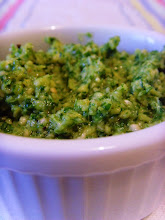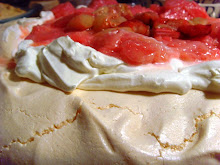As I've already mentioned, our new house has an Aga in the kitchen. The news has been met with a mixture of excitement and trepidation from my husband and I, wedded as we are to the happy combination of gas hob and electric oven. I've always loved the idea of an Aga but have, at the same time, been slightly wary of the reality. No set temperatures, a permanently hot kitchen, no cooking smells to warn you when your cake is starting to burn... On the other hand, I love to see dogs snuggling up to the Aga after a wet and wild walk on a chilly winter day. I love to see sheets carefully folded on the Aga knowing that they will require no ironing. And I love the concept of popping a casserole in the simmering oven and leaving it for hours, knowing it will come to no harm.
Keen to have a go at befriending our new appliance, we decided to visit our local Aga store in search of tips. We were interested to discover that the store held a varied programme of events, cooking demonstrations and classes. I was particularly drawn to a class entitled 'A Day in the Life of an Aga' and yet more delighted when I discovered that it only cost £7.50 to attend (prices seem to vary according to location).
 |
| Aga toast: crisp on the outside and soft in the middle |
So, on Tuesday night, the two of us turned up at the Aga shop eager to learn whatever we could about Aga cookery. I am pleased to report that it may well prove to be the best £15 ever spent! The evening was ably hosted by Marcia Poole who started by asking each of us to describe our Aga situation. There was an audible gasp from the audience when we mentioned that we had a solid fuel fired Aga and we felt a little more nervous about what we are letting ourselves in for. Oil or gas-fired would definitely be simpler it seems...
Marcia then set to work showing us how to get the best from the Aga. What followed was quite miraculous and highlighted the versatility of Aga cooking. Although she was using a four-door Aga, she did most of the cooking in the roasting and simmering ovens so that those of us with a mere two doors didn't feel too left out. At the peak of her performance she managed to have the following items cooking simultaneously in the ovens: a full English breakfast, a roast chicken, a plum crumble, sweet potatoes, carrots, cauliflower, white sauce for the cauliflower, rice, shortbread, a vegetable curry, an apple sponge cake, two salmon steaks and a quiche. All these items were cooking along happily yet the Aga didn't look as though it was doing a thing. For good measure she also whipped up some Chelsea buns and cooked drop scones and a stir-fry on the hot plates.
 |
| The food, almost all of which was cooed in (rather than on) the Aga |
This is the trick to successful Aga cookery. Using the ovens as much possible and keeping the lids down in order to keep the heat in. Root vegetables should be started on the hot boiling plate and then should be drained of their water and transferred in their saucepans to the simmering oven where they happily steam away slowly until you are ready for them. The beauty of the simmering oven is that it is very hard to overcook things - you can do the veg ahead of time and stow them out of sight in the oven until your roast is ready. No last minute stress getting hot and bothered over pans of boiling veg! The Aga ovens are deceptive too - they go back a long way and you can fit a surprising number of pans inside. Marcia had six saucepans in the simmering oven at one point.
 |
| The simmering oven containing six pans |
Another favourite 'trick' she showed us was how to cook a fatless ' fried' egg on the cooler of the two hot plates. You take a sheet of bake-o-glide, crack an egg into the middle and then put the lid down over the egg. In a few minutes, lift the lid to find a perfectly cooked egg without the need for oil or butter. Toasted sandwiches can be made this way too.
 |
| 'Fried' breakfast with no added fat |
We watched in awe as she raced through the method for cooking perfect rice and pasta and listed carefully when she explained that Aga casseroles need less liquid than usual. I was particularly interested in the way she cooked her quiche - no need for blind baking as you can fill a raw pastry case and place it on the floor of the Aga ensuring a perfectly crisp pastry on the bottom.
After the whirlwind session we were allowed to sample the food - delicious, all of it - and had a chance to ask further questions. We'd learnt a huge amount in a short space of time and returned home totally sold on Aga cookery and ownership and dying to get our Aga up and running (we are currently waiting for a chimney sweep to come and clean the flue and check it over as it hasn't been used in an age).
 |
| Drop scones cooking directly on the simmering plate |
We are slightly dismayed to find that our Aga does not come with the standard bits of Aga equipment and it looks as though we are going to have to start saving as the roasting tins, kettle and toast rack are fairly essential (and not exactly cheap). The Aga saucepans are cleverly designed to stack on top of each other in the ovens to make most use of the space and certainly a desirable extra but sadly a little expensive for us (and we do have very good new pans which can go in the ovens).
Overall, we are more excited than ever about the Aga and, with a little practice, firmly believe that cooking on it will be a great pleasure. If you own an Aga, or are thinking of intalling one, I would thoroughly reccomend the in-store classes. This was a basic class for 'beginners' really but could be a useful refresher for seasoned Aga cooks. However, there are many other sessions to choose from including classes on baking and cooking the Christmas lunch!



















8 comments:
Oooooh! Lucky you I am so jealous! I can't wait to have an aga again.... drop scones on an aga are one of life's greatest pleasures! Enjoy...
Mxxx
great blog, so insightful and up to date
Andy
the-food-place
Wow, I am really jealous! I've always wanted an AGA. I never knew they could cook so much at once!
I think your lesson was great value. If I was the fortunate owner of an Aga I too would have to attend classes. There is definitely something cosy about Aga's...........
I never knew you could do so many thing in an Aga - at the same time. Great insight into an unknown world.
We too are new "Aga" owners...and in the states no less! We took the class (once I'd finally located a "previously loved" stove) and found that it did so much more than anticipated! For me, the main drawback is that so few people here even know what an Aga is, so I rely on the web quite a bit for help.
Enjoy ....
- Kaye
Kaye - good luck with your new Aga. There are some really good books available here that may help - I've got one by Amy Wilcock who is a great Aga cook. Mary Berry is another to look out for. I'm sure you could find them online. Hope you enjoy using your Aga. Ours is still not up and running - it is being serviced next week though. I can't wait!
I love Aga's but sadly only Martha Stewart owns one in the U.S. I think anyway. This was so much fun to read.
Post a Comment